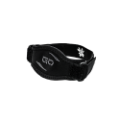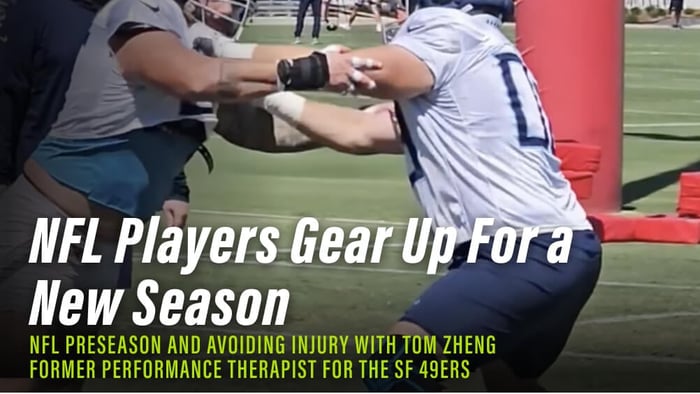Injuries are thought of as an inevitability in sports, especially in the game of football. With the NFL season upon us, we see this firsthand with the inevitability of growing injury lists. Even with professional players working out year-round, what makes athletes more susceptible to injury during pre-season? We asked Tom Zheng, a health and performance expert who spent three seasons with the San Francisco 49ers, how everyday athletes can help avoid injury, especially during training phases, and how NFL players use GO Sleeves to help on and off the field.
Tom Zheng, former Performance Therapist for the 49ers with a master’s in kinesiology and applied exercise science, a Ph.Dc in human health and performance and organizational leadership, and a current member of the GO Sleeves team, gives us insight into NFL preseason and what players’ bodies go through day-to-day. With a growing number of professional players using GO Sleeves kinesiology sleeves and K-Recover Cream, Tom shares insight into recovery, kinesiology principles, and how GO Sleeves can help every body—from the weekend warriors to avid gardeners and, of course, professional athletes.
My Ph.D. area of expertise is in human health and performance, with an organizational leadership add-on. I have a master’s in kinesiology, and applied exercise science, as well as experience in biology and psychology. I was the performance therapist for the 49ers from 2018 to 2022. Since then, I have worked with several professional leagues, including professional football, professional basketball, professional lacrosse, and professional golf.
This time of year, we are in the midst of NFL training camp, and it is the hardest time of year for NFL players with schedule demands, physical demands, and mental demands. A lot of the players are new. This is their first exposure to the team, the coaching style, and all of the inner workings and logistics that come with being a player in the NFL. As a sports scientist, this is a crucial part of the season to support these athletes because when they are under duress, mental stress, etc., they are substantially more likely to be injured. You often see that training camp has one of the highest spikes for soft tissue injuries, non-contact injuries, and, in some cases, critical season-ending injuries.
This time of year, particularly during training camp, it's not unusual for athletes and staff members to be at the facility for 15 hours daily. On top of that, each athlete will be both sedentary and extremely active throughout the day. Players will have a 90-minute to two-hour high-intensity practice that creates a lot of physical duress on their bodies. In addition, they are learning the new playbook, going through many skills, and attending meetings that take up most of the day. A gross majority of the day, they're sitting. So that places a whole different stressor, particularly on your hip joints, knee joints, ankle joints, and even your elbow and shoulders, depending on your posture, are also affected. A stationary body could be better in any capacity.
Active Vs. Passive Recovery
With that being said, there are many aspects of athletic recovery. Two significant areas of recovery work are active recovery, as well as passive recovery.
- Active recovery is when you are moving your body, intending to get joint movement or muscle activity to improve blood flow, lymphatic drainage, joint integrity, and muscle elasticity to aid in recovery.
- Passive recovery, which I think is one of the most important types of recovery—especially for NFL players as they alternate between the field and the meeting room. Passive recovery provides your body the necessary stimulus to improve its physiology to recover faster than you usually would, without actively having to do much physically. GO Sleeves products are a perfect example of aiding in passive recovery. They act as a passive application because a player can just pull on and wear a sleeve to support their body in the recovery process—while they're sitting in a meeting, walking around the facility, breaking for lunch, etc., the sleeve is still working to support their body’s natural capacity to recover. It combines a unique combination of compression and kinesio technology to help improve circulation and lymphatic fluid drainage. Simultaneously, the compression element of the sleeve helps manage the joint’s overall swelling.
 SF 49ers Defensive End Spencer Waege testing out GO Sleeves Knee Sleeves
SF 49ers Defensive End Spencer Waege testing out GO Sleeves Knee Sleeves
Understanding Kinesiology and how GO Sleeves Can Help
Kinesiology, at a base level, is the study of movement. Technology like GO Sleeves was created and implemented to help improve motion and help restore your body’s basic functionality in joints, musculature, etc. But GO Sleeves technology doesn’t stop at helping with functionality. GO Sleeves applied principles of kinesiology to improve your body’s physiology—to help it get back to the state before injury or wear and tear. That’s the magic here.
In addition to kinesiology sleeves, the GO Sleeves K-Recover Cream acts as a primer to help you improve the elements in and underneath your skin, making the kinesio tech sleeve more effective in reducing inflammation in the application area. The K-Recover cream has active ingredients that affect a different portion of your physiology, particularly if you're an athlete and have been under a lot of physical and nervous duress. And nervous is just a broad term for all the mental stressors that you might be going through.
MAGNESIUM
One of the most prominent and well-known active ingredients is magnesium. It plays a crucial role in supporting musculature in the rebuild process and another added benefit of affecting your nervous system. It stimulates the parasympathetic nervous reaction, a broader term that points to the state your body takes as it calms down to prepare for a state rest. Magnesium stimulates your body to go into that rest state, a state your body requires to properly recover. One of the perfect applications for K-Recover Cream is post-activity to allow your body to actually rest, recover and relax.
GLUCOSAMINE
Glucosamine is used by the body to make other chemicals that build tendons, ligaments, cartilage, and the fluid that surrounds joints. Joints are cushioned and supported by the fluid and cartilage around them. Taking glucosamine might increase the cartilage and fluid around joints to help prevent their breakdown. Applying the cream to a part of the body, like your knee, while you're sitting in a meeting will help with the lubrication of the joint.
ARNICA
Arnica acts as an anti-inflammatory, which is important post-activity when you have a lot of blood flow, you have a lot of swelling, you have a lot of active pain sensors. When you have joints that are in duress due to physical activity, the arnica helps to decrease that inflammatory function and stimulate a rest and recovery aspect that you usually wouldn't get, at least not for another couple of hours after the activity.
 Oakland University Defensive End Marquise Greenwood squatting in GO Sleeves Knee Sleeves
Oakland University Defensive End Marquise Greenwood squatting in GO Sleeves Knee Sleeves
Everyday Use for Every Body
Whether you are hiking during the day, you garden on the weekends, or you are a professional athlete, this applies to everyone. We are anatomically mostly the same, with slight differences in genetic structure and epigenetics, which are genetics developed based on your daily habits. The only main difference is the activity level that an average person, like myself, goes through versus a professional athlete, who endures much more stress on their body.
A lot of the days for NFL players, they're sitting in meetings, doing the same exact thing that I am doing right now. I'm just sitting in front of the computer in a sedentary position, talking or listening throughout my day. That said, the recovery process for everybody is, again, no different than an NFL athlete. You still develop a lot of that wear and tear, those inflammation markers, joint stiffness, and the like. The difference is that you and I are not undergoing immense physical preparation, but we’re still doing damage to our bodies. What makes GO Sleeves a unique approach is it gives you the chance to reduce that wear and tear not just while you’re moving but also as you're just sitting. So when you do decide to get back into action, whatever that action might be, your body will be in a better position to support you. And you’ll be less likely to get hurt. That’s a win for everyone.
Tom Zheng is a Ph.D. in human health, performance, and organizational leadership. He also holds Masters in Applied Exercise Science and Kinesiology. His 9 years as a Health and Sports Scientist are highlighted by tenure as the Performance Therapist for the San Francisco 49ers.
He is the founder of Adapt Health and Performance – a venture committed to revolutionizing health and performance in the athletic sphere. He also serves as the Chairman for PlayersOnly Network, a platform aimed at helping athletes develop and monetize their brands, and as an Advisor for GO Sleeves, creators of the World’s Only Kinesiology Sleeves.











